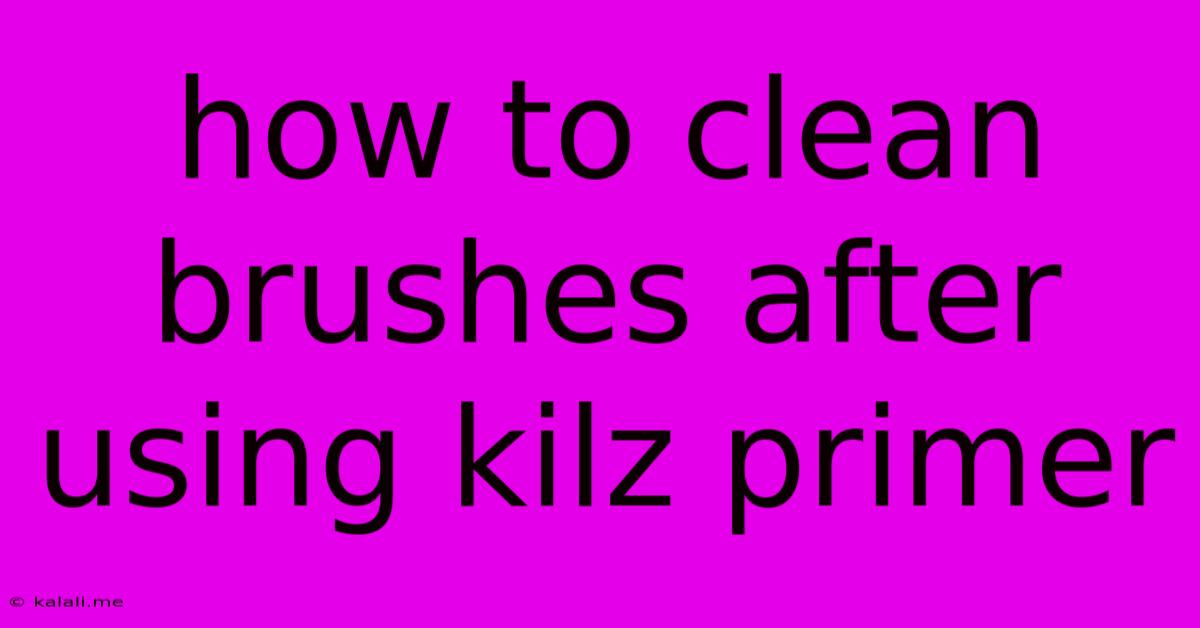How To Clean Brushes After Using Kilz Primer
Kalali
Jun 05, 2025 · 3 min read

Table of Contents
How to Clean Brushes After Using Kilz Primer: A Comprehensive Guide
Kilz primer is a powerful tool for prepping surfaces before painting, offering excellent adhesion and stain blocking. However, its thick, tenacious nature makes cleaning brushes a crucial step to maintain their longevity and prevent future painting woes. This guide provides a step-by-step process on how to effectively clean your brushes after using Kilz primer, ensuring they're ready for your next project. Proper brush cleaning also extends the lifespan of your tools, saving you money in the long run.
Understanding the Importance of Thorough Cleaning
Failing to clean your brushes properly after using Kilz primer can lead to several issues:
- Hardened bristles: The primer dries quickly, hardening the bristles and rendering the brush unusable.
- Clogged bristles: Dried primer clogs the brush's fibers, impacting its ability to hold and apply paint evenly in future projects.
- Wasted brushes: A poorly cleaned brush will likely need to be discarded, leading to unnecessary expenses.
- Contaminated paint: Dried primer residue can contaminate subsequent paint projects, affecting color consistency and finish.
Gathering Your Cleaning Supplies
Before you begin, gather the following materials:
- Brush cleaner: Mineral spirits, paint thinner, or a specialized brush cleaner designed for oil-based primers are recommended. Always check the Kilz primer's product label for recommended cleaning solvents.
- Container: A metal container or disposable bucket is ideal. Avoid using anything you value since the cleaning process can be messy.
- Old rags or paper towels: Plenty of these will be needed for wiping.
- Warm water: For rinsing.
- Mild soap: For final rinsing (optional).
- Stiff-bristled brush: (optional) To help scrub stubborn primer from bristles.
Step-by-Step Cleaning Process
1. Immediate Action: The key to successful brush cleaning is prompt action. The sooner you clean your brushes after using Kilz primer, the easier it will be.
2. Remove Excess Primer: Before starting the cleaning process, gently scrape away excess primer from the bristles using a putty knife or palette knife. This removes a significant amount of the primer, making the cleaning process more efficient.
3. Initial Soak: Submerge the brush completely in your chosen brush cleaner (mineral spirits or paint thinner). Allow it to soak for at least 15-30 minutes, or even longer for heavily loaded brushes. This softens the dried primer, making it easier to remove.
4. Scrubbing and Working the Bristles: After soaking, use a stiff-bristled brush or your fingers to work the cleaner into the bristles, gently but firmly agitating them to loosen and remove the primer. Pay close attention to the base of the bristles where primer tends to accumulate.
5. Rinse and Repeat: Rinse the brush thoroughly with warm water. Repeat steps 3 and 4 as needed until the water runs clear and no more primer is released. You may find that several rounds of soaking and scrubbing are required for a complete clean.
6. Final Rinse and Conditioning: For a final cleaning, wash the brush with warm water and a small amount of mild soap. Rinse thoroughly to remove any soap residue.
7. Reshaping and Drying: Gently reshape the bristles into their original form. Lay the brush flat on a clean cloth or paper towel, allowing it to air dry completely. Avoid storing it in a plastic container or bag while still wet to prevent mildew.
Choosing the Right Cleaning Solvent
While mineral spirits are commonly used, always refer to the Kilz primer's specific instructions for recommended cleaning solvents. Using an incompatible solvent might damage the brush or not effectively remove the primer. Always work in a well-ventilated area when using solvents.
Maintaining Your Brushes
Proper storage is also crucial. Store your cleaned brushes in a cool, dry place, away from direct sunlight and extreme temperatures.
By following these steps, you can effectively clean your brushes after using Kilz primer, preserving your tools and ensuring they're ready for future painting projects. Remember that consistency and prompt action are key to maintaining high-quality brushes and achieving the best possible results.
Latest Posts
Latest Posts
-
Territorial Behavior In Humans An Analysis Of The Concept
Jun 06, 2025
-
Its Right Behind Me Isnt It
Jun 06, 2025
-
How Many Ounces Is In A Box Of Powdered Sugar
Jun 06, 2025
-
Should You Use We Ll Keeo Or Will Keep
Jun 06, 2025
-
How To Turn Off Calls On Iphone
Jun 06, 2025
Related Post
Thank you for visiting our website which covers about How To Clean Brushes After Using Kilz Primer . We hope the information provided has been useful to you. Feel free to contact us if you have any questions or need further assistance. See you next time and don't miss to bookmark.